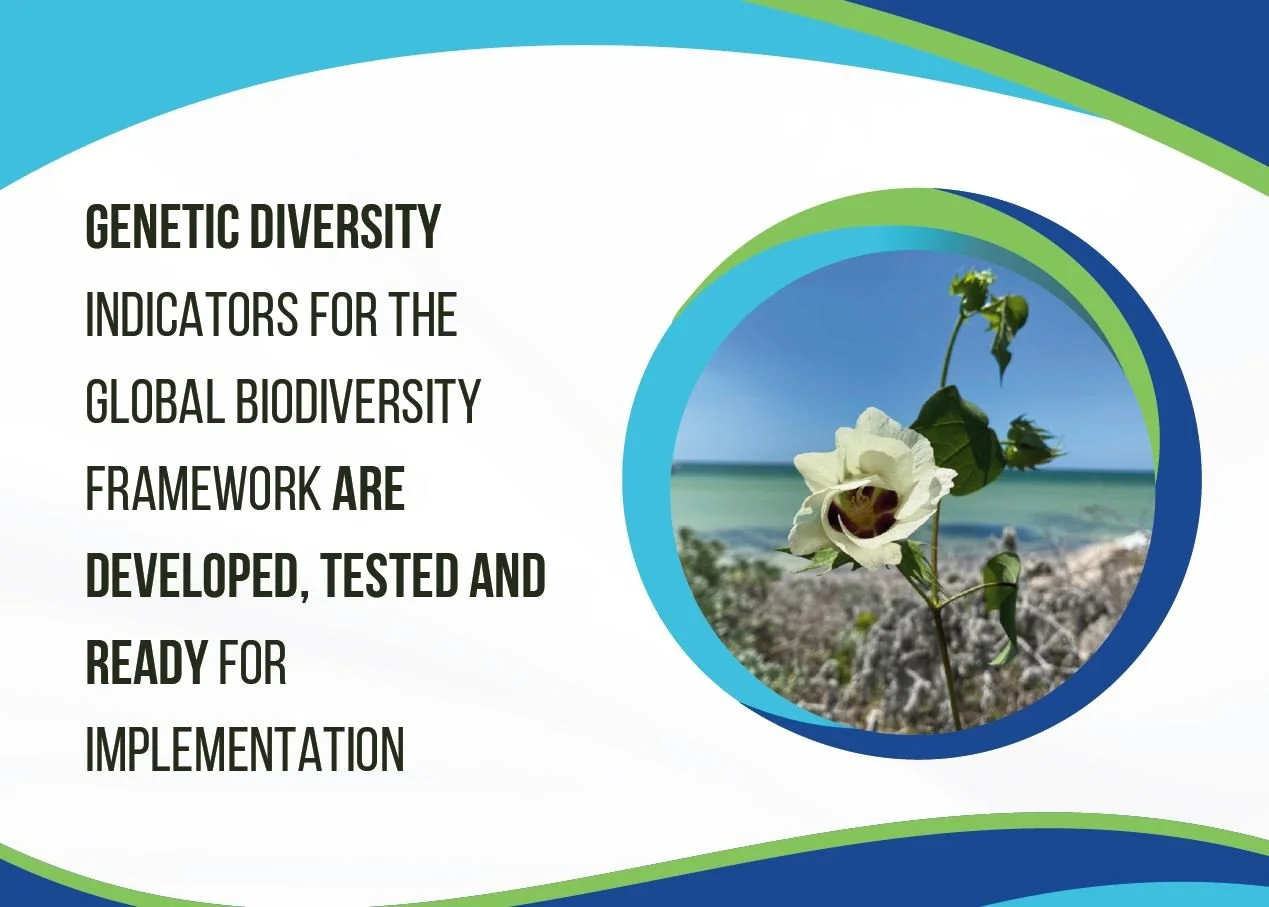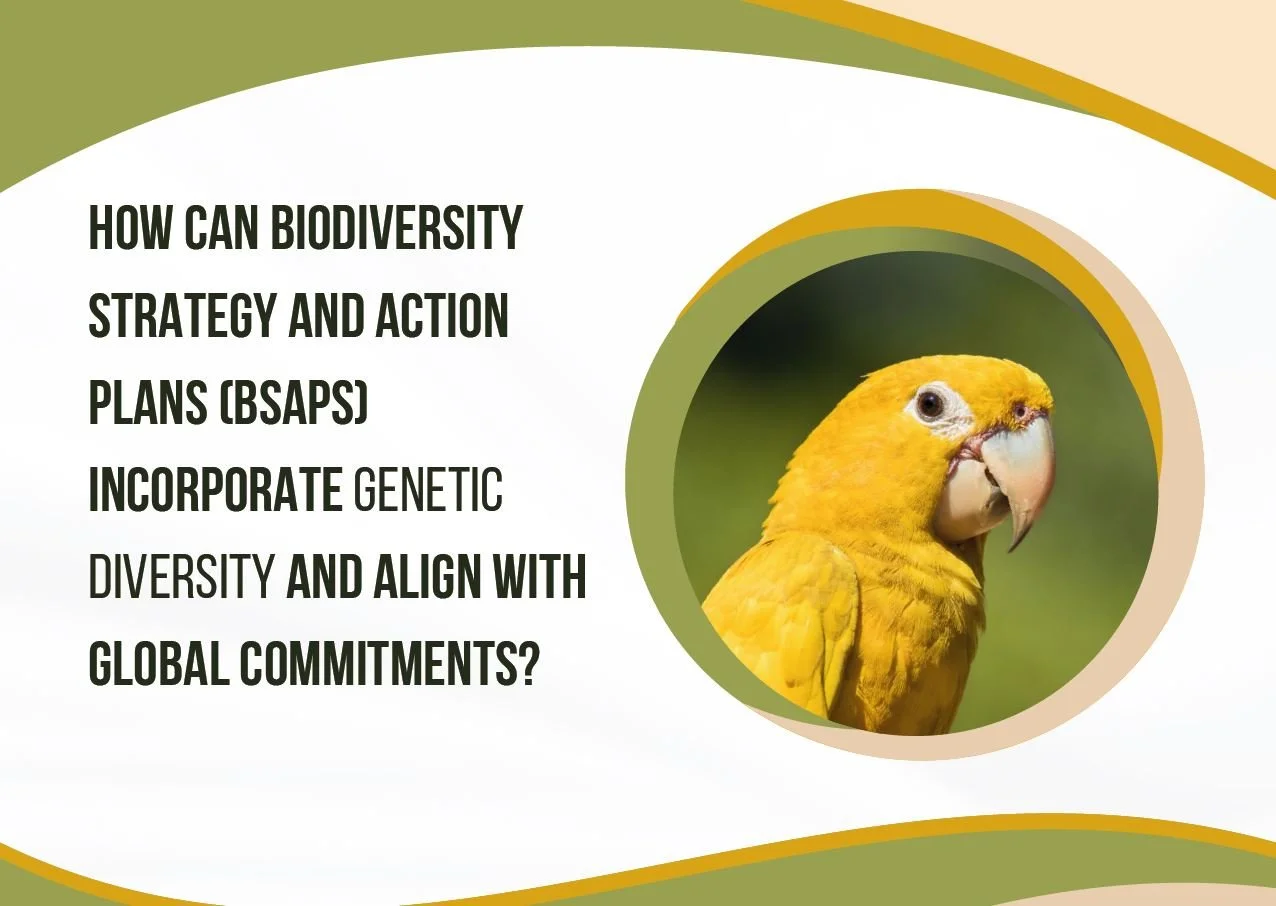Genetic diversity at COP16
Sixteenth meeting of the Conference of the Parties to the Convention on Biological Diversity (COP 16)
Want to learn more about genetic diversity indicators for the Kunming-Montreal Global Biodiversity Framework (GBF)? Scroll down to browse the essential resources we’ve compiled for COP16.
Why is Genetic Diversity important?
Genetic diversity plays a crucial role in maintaining healthy ecosystems, ensuring food security, and supporting society as a whole. Without diverse genetic resources, ecosystems can’t adapt to change, which can have widespread effects on agriculture, climate resilience, and biodiversity.
Are you at COP and want to find us?
Experts in conserving and restoring genetic diversity and adaptive potential are attending COP16! We will be present at a booth titled Coalition for Conservation Genetics! We will also be a part of the following events:
Side event on Global Strategy for Plant Conservation
Tuesday 10.22 @ 11:40. Room: Cocora. Alicia Mastretta Yanes will talk about genetic diversity indicators, genetic diversity and crop wild relatives, and similar topics.
Side event on GEO BON Bon in a Box
10.22 @ 11:40 AM. Room: Nuqui “BON in Box as a tool for implementation and reporting on the monitoring framework”. There will be a presentation on genetic diversity indicators and a pilot tool for semi-automated calculation of indicators (with translation in several languages - Spanish, Chinese, French), focusing on BON in a Box and Genes from Space.
Event at IUCN Pavilion
10.26 @ 2:15 to 3:45 PM: “Considering the opportunities offered by new tools for conservation”. Alicia Mastretta Yanes will talk about genetic diversity indicators.
Event at GEO BON Pavilion
This pavilion event will be about genetic diversity indicators and reporting on genetic diversity. There are two sessions, one in English and one in Spanish. Food and coffee will be provided.
Spanish 10.25 @ 16:45-18:15 PM.
English 10.26 @ 10:00 - 11:30 AM.
Session during Science Policy Forum
10.27 @ 11:50 - 13:15. “Integrating Science and Data for Effective NBSAPs and Community Engagement”. Katie Millette of GEO BON is speaking about genetic diversity and NBSAPs.
Event at European Union Pavilion
10.25 @ 15:30 – 17:00. “Science policy discussion”. A representative of the Coalition for Conservation Genetics will join a panel speaking about supporting monitoring and reporting, including with genetic diversity.
Achievable and Affordable Indicators
Measuring genetic diversity is feasible, achievable, and affordable. The genetic diversity indicators we have developed provide valuable insights for both conservation and sustainable development goals. Parties to the CBD are now required to report progress using the following indicators:
1. Proportion of populations within species with an effective population (Ne) size > 500 (Headline indicator A.4.0).
This threshold is vital for preventing losses of genetic diversity within populations, allowing populations to adapt to new conditions, climate change, and diseases.
2. Proportion of populations maintained within a species (additional complementary indicator).
This indicator is important as diversity among populations maintains evolutionary potential across a species' distribution.
evaluating genetic diversity indicators in nine countries
In a recent paper in Ecology Letters, we assess the genetic diversity indicators for the Kunming-Montreal Global Biodiversity Monitoring Framework for 919 species, representing 5271 populations across nine countries, including megadiverse countries and developing economies. We show that the indicators are ready for implementation. Watch the short (5-minute) video and follow the link below to learn more.
Tools Available Now
The tools for calculating these genetic diversity indicators are already available and continually improving. This includes a meta-data form for indicator A.4, guideline materials and documentation and integration with resources like BON in a Box, a platform designed to enhance biodiversity observation systems globally.
Flexibility in Implementation
There’s no one-size-fits-all approach. While we’ve developed tools and support with our member organizations (GEO BON, G-BiKE, IUCN, and SCB) and through initiatives like GENOA and GINAMO, countries are free to adopt their own methods and do not have to follow the exact same pathway we used.
Our teams are committed to fostering collaboration between scientists and practitioners. We provide opportunities for networking and capacity building to ensure the successful implementation of genetic diversity indicators.
We encourage delegates to share their concerns, questions, or issues regarding the genetic diversity indicators and tools like Kobo and BON in a Box. Your feedback will help us improve these tools and make them more useful in practice.
You can get in touch by heading to our booth or one of our events at COP16 (listed above) or via this webform.
Need Advice on NBSAP Development?
We can provide advice and resources to support countries in developing their National Biodiversity Strategies and Action Plans (NBSAPs), ensuring genetic diversity is well-represented.
An important message from the CCG regarding DSI…
It's important to clarify the terms “Digital Sequence Information (DSI)” and “genetic diversity”, especially regarding monitoring and reporting genetic diversity.
Genetic diversity describes the variation within a species, important for adaptation and resilience to change. Genetic diversity metrics and indicators describe the genetic health of populations or species. They are useful for management and for monitoring change over time. Genetic diversity statistics and indicators may be derived using genetic data but can also be derived using other data, including proxies like population size (e.g. the Headline Indicator on genetic diversity). Importantly, genetic diversity statistics or indicators can be reported as summary statistics.
DSI, on the other hand, is data at the DNA sequence, protein or similar level, commonly for an individual organism. While some DSI data types may be used to calculate genetic diversity, genetic diversity indicators do not necessarily require the use of DSI, and reporting genetic diversity statistics also does not require the use of DSI.
The CCG will be available throughout COP16 and beyond to help clarify these terms and concepts and can provide scientific guidance on genetic diversity monitoring and reporting, with or without the use of DSI. We look forward to engaging and learning more about this evolving topic at COP16. You are welcome to visit us at our booth for further discussion.
Interested in working with or learning from the Coalition for Conservation Genetics?
Follow the link below to stay informed about our activities, including upcoming webinars, training sessions, and capacity-building opportunities.














